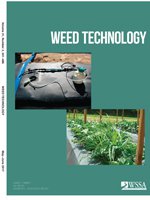With the recent introductions of glyphosate- and dicamba-tolerant crops, such as soybean and cotton, there will be an increase in POST-applied tank-mixtures of these two herbicides. However, few studies have been conducted to evaluate drift from dicamba applications. This study aimed to evaluate the effects of dicamba with and without glyphosate sprayed through standard and air induction flat-fan nozzles on droplet spectrum and drift potential in a low-speed wind tunnel. Two standard (XR and TT) and two air induction (AIXR and TTI) 110015 nozzles were used. The applications were made at 276 kPa pressure in a 2.2ms-1 wind speed. Herbicide treatments evaluated included dicamba alone at 560 g ae ha-1 and dicamba glyphosate at 560 1,260 g ae ha-1. The droplet spectrum was measured using a laser diffraction system. Artificial targets were used as drift collectors, positioned in a wind tunnel from 2 to 12 m downwind from the nozzle. Drift potential was determined using a fluorescent tracer added to solutions, quantified by fluorimetry. Dicamba droplet spectrum and drift depended on the association between herbicide solution and nozzle type. Dicamba alone produced coarser droplets than dicamba glyphosate when sprayed through air induction nozzles. Drift decreased exponentially as downwind distance increased and it was reduced using air induction nozzles for both herbicide solutions.
Nomenclature: Dicamba; glyphosate; cotton, Gossypium hirsutum L.; soybean, Glycine max (L.) Merr.





